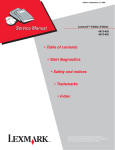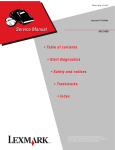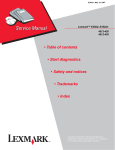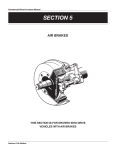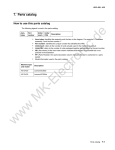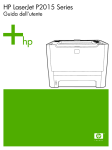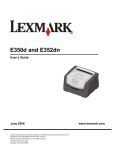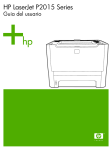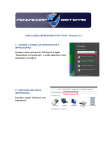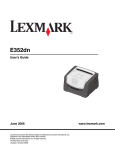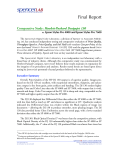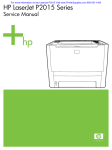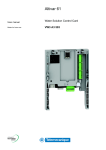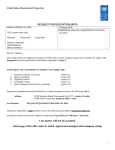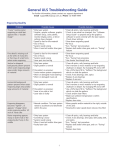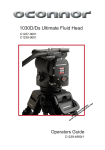Download Print Quality, Recycled Paper Usage Testing, Ease-of
Transcript
1 Print Quality Analysis, Recycled Paper Usage Testing, Ease-of-Use/Functionality Comparative Study Test Results Integrated Print Cartridge vs. Multi-Piece Toner/Photoconductor Drum Systems HP LaserJet P2015 Brother HL-5240, Dell 1720, Kyocera FS-1030D, and Lexmark E350d Monochrome Laser Printers April 2007 spencerLAB DIGITAL COLOR LABORATORY Catherine Fiasconaro, Vice President - Operations, Director Spencer & Associates Publishing, Ltd. David R Spencer, President Melville, New York 1.631.367.6655 This research was conducted by SpencerLab Digital Color Laboratory, under commission by Hewlett-Packard. Research results and analysis represent our best knowledge at time of publication, and are based upon testing procedures developed and implemented by SpencerLab in our continuing commitment to accuracy, integrity, and our broad base of industry clients. www.spencerlab.com ©2007 Spencer & Associates Publishing, Ltd. 2 Agenda • Executive Summary ° Project Objectives ° Test Results Overview • Print Quality Analysis ° Methodology ° Test Results • Recycled Paper Usage Testing ° Methodology ° Test Results • Ease-of-Use/Functionality www.spencerlab.com ©2007 Spencer & Associates Publishing, Ltd. 3 Executive Summary - Project Objectives Conduct Comparative Test and Analysis of the HP Integrated Print Cartridge and Competitive Multi-Piece Toner/Photoconductor Drum Systems HP LaserJet P2015 Brother HL-5240 Dell 1720 Kyocera FS-1030D Integrated Print Cartridge Separate Toner and Photoconductor Drum Cartridges (one-piece system) (multi-piece systems) Lexmark E350d Comparative study includes: °Print Quality Analysis •Including elements of Text, Lines, Tints, Blends, and Images °Recycled Paper Usage Testing •Analyze Print Quality performance over the running of 5,000 pages printed on recycled media °Ease-of-Use/Functionality •Compare typical user experiences based upon set-up and installation, control panel interaction, printer driver/software, functionality, technical support, reliability, and general observations www.spencerlab.com ©2007 Spencer & Associates Publishing, Ltd. 4 Executive Summary — Test Results Overview Comparative Test and Analysis ° Print Quality Analysis • HP LJ P2015 produces high quality output, superior or comparable to competitive printers in elements of Text, Lines, Tints, Blends, and Images • HP Text, Tints and Blends are superior to competitive printers • HP Lines and Images are comparable to competitive printers ° Recycled Paper Usage Testing • HP LJ P2015 exhibited no visible defects over 5,000 printed pages attributable to photoconductor drum stress or dust accumulation • Integrated print cartridge design ensures that the drum is replaced on a regular basis—mitigates long-term, drum-related print quality issues • Brother HL-5240 output showed defects due to paper dust accumulation as early as 1,000 pages, which persisted throughout the remainder of the test, even after a cartridge change and the execution of a manufacturer-recommended cleaning procedure • Dell 1720, Kyocera FS-1030D, and Lexmark E350d all produced output with banding visible in high-coverage areas of the test file, from the first benchmark page (page 50) throughout the remainder of the test • Kyocera FS-1030D output also darkened over time ° Ease-of-Use/Functionality • HP LJ P2015 offers user-friendly features and reliability • The HP integrated print cartridge design allows for simple consumable maintenance • Tested Brother, Dell, Kyocera, and Lexmark printers require increased user intervention during replacement of their multi-component consumables • Kyocera FS-1030D driver installation and software usage was fraught with issues • Lexmark E350d and Dell 1720 feature intelligent output tray sensors • Pause print jobs when printer detects that the tray is full, and resume jobs automatically when output is removed • Most printers are capable of duplexing out of the box • Higher-end HP LJ P2015 Series models (P2015d, P2015dn, P2015x) are capable of automatic duplexing; base model is not • All printers are lightweight and have small footprints • All printers have a wide range of support for current operating systems • Telephone support experiences varied from manufacturer to manufacturer • HP and Brother telephone support technicians were very knowledgeable and responsive • Kyocera and Lexmark telephone support technicians were helpful but slow to resolve calls • Dell telephone support technicians were lacking in basic knowledge and slow to resolve calls * Cartridge End-of-Life was determined according to ISO 19752 methodology adapted for the scope of testing: the first of either a Toner Out signal or the third conclusive Fade exhibited by output (first Fade if no cartridge shake procedure is defined in the printer’s documentation) www.spencerlab.com ©2007 Spencer & Associates Publishing, Ltd. 5 Print Quality Analysis — Methodology Enhanced Black Color Spectrum Newsletter Analysis Procedure ° Results based on element types, including: • Black Text — legibility, typography, reverse text • Lines — angled/curved line thickness, uniformity and smoothness • Tints — gray tint uniformity • Blends — gray blend linearity • Images — overall quality, including sharpness, contrast, highlight and shadow details Castle SpencerLab/CRN PQ Lite ° SpencerLab Test Suite test documents utilized • Range of test documents, covering a variety of printing requirements • Printed on each of the printers in their respective default modes for Plain Paper • A single printer of each manufacturer was used in analysis and assumed to be representative • Printed on plain office paper, Staples Copy Paper, 92 brightness, 20 lb. • Test documents printed using Adobe Acrobat Reader 8.0 Babies La Boca www.spencerlab.com ©2007 Spencer & Associates Publishing, Ltd. 6 Print Quality Analysis — Results Overall, HP LaserJet P2015 Print Quality is superior to competitive printers ° Black and Reverse Text • HP Text is exceptionally sharp and well-rendered ° Lines • HP Black Lines are smooth and sharp • Lines are rendered a bit too thick ° Tints • HP Tints are screened well and appear smoother than output produced by competitive printers ° Blends • HP Blends have even transitions and are more uniform than competitive prints ° Images • HP Images exhibit good edge sharpness in areas of high contrast • Expanded midtone range results in low overall contrast • Highlight and shadow details are rendered well Print quality generalizations apply to default modes, unless otherwise stated www.spencerlab.com ©2007 Spencer & Associates Publishing, Ltd. 7 Print Quality Analysis — Results (cont’d) Text HP LJ P2015 Kyocera FS-1030D Characters are crisp and well-defined Some toner splatter visible under magnification Black Text is legible to 2 points, dropout-free to 4 points Reverse Text is legible to 4 points, dropout-free to 8 points Brother HL-5240 Under magnification, characters exhibit stepping patterns Black Text is legible to 2 points, dropout-free to 4 points Reverse Text is legible to 4 points, dropout-free to 8 points Dell 1720 Under magnification, characters exhibit stepping patterns Some toner splatter visible under magnification Black Text is legible to 4 points, dropout-free to 4 points Reverse Text is legible to 4 points, dropout-free to 10 points Lexmark E350d Under magnification, characters exhibit stepping patterns Starting at 10 points, some fine strokes are rendered too thin Black Text is legible to 4 points, dropout-free to 8 points Reverse Text is legible to 4 points, dropout-free to 10 points Under magnification, characters exhibit stepping patterns Black Text is legible to 2 points, dropout-free to 10 points Reverse Text is legible to 4 points, dropout-free to 8 points HP LJ P2015 Brother HL-5240 Dell 1720 Kyocera FS-1030D www.spencerlab.com ©2007 Spencer & Associates Publishing, Ltd. Lexmark E350d 8 Print Quality Analysis — Results (cont’d) Lines HP LJ P2015 ° Radial lines are sharp and crisp, but rendered a bit thick ° Reverse Radial lines are crisp and easily distinguishable ° Some fine lines on the Mazda car drawing are rendered too thick, resulting in loss of fine detail ° Curved lines are reproduced at requested thicknesses down to 300 dpi HP LJ P2015 • Minor stepping visible on thin Curved lines Brother HL-5240 ° Radial lines are finely rendered ° Reverse Radial lines are rendered too thin, and are almost completely filled in at 45º diagonal intervals ° Fine lines are rendered appropriately on the Mazda car drawing and show fine details • Some stepping visible on Angled and Curved fine lines Brother HL-5240 ° Curved lines are reproduced at requested thicknesses down to 600 dpi Dell 1720 ° Radial lines are distinguishable, but appear dotted and broken ° Reverse Radial lines are completely filled in ° Fine lines are rendered too thin on the Mazda car drawing • Thicker Curved and Angled lines appear stepped; thinner lines appear dotted ° Curved lines are not uniformly rendered at resolutions higher than 1/4-point Dell 1720 Magnification at approx. 100% www.spencerlab.com ©2007 Spencer & Associates Publishing, Ltd. 9 Print Quality Analysis — Results (cont’d) Kyocera FS-1030D ° Radial lines are distinguishable, but rendered too thick ° Reverse Radial lines are distinguishable but not uniform ° Lines on the Mazda car drawing are rendered too thick and are uniform, resulting in loss of fine detail and perceived image depth ° Curved lines are reproduced at requested thicknesses down to 300 dpi Kyocera FS-1030D Lexmark E350d ° Radial lines are rendered too thin, and drop out completely at 45º diagonal intervals ° Reverse Radial lines are completely filled in ° Fine lines on the Mazda car drawing are dotted and subject to dropouts; some lines are not rendered at all ° Curved lines are not uniformly rendered at resolutions higher than 1/4-point; 600 dpi curve segment drops out almost completely Lexmark E350d Magnification at approx. 100% www.spencerlab.com ©2007 Spencer & Associates Publishing, Ltd. 10 Print Quality Analysis — Results (cont’d) Tints HP LJ P2015 ° Tints are screened well and free from banding, mottle, and grain ° Good differentiation at varying percentages (10%90%) Brother HL-5240 ° Tints are grainy due to halftoning ° Midtone range is expanded, with little differentiation between some adjacent percentages (30%-40%, 5060%, 70-80%) Dell 1720 ° Tints are halftoned well; free from mottling, slightly grainy ° Good differentiation at varying percentages (10%90%) Kyocera FS-1030D ° Tints are mottled and grainy ° High contrast shows in expanded highlight and shadow ranges, little differentiation between some adjacent percentages (20%-40%, 70-80%) Lexmark E350d ° Tints are halftoned well; free from mottling, slightly grainy ° Little differentiation in highlight range (20-40%) Magnification at approx. 200% HP LJ P2015 Brother HL-5240 Dell 1720 www.spencerlab.com ©2007 Spencer & Associates Publishing, Ltd. Kyocera FS-1030D Lexmark E350d 11 Print Quality Analysis — Results (cont’d) Blends HP LJ P2015 ° Blends have smooth transitions ° Midtone range is somewhat wide, resulting in diminished highlight and shadow ranges ° Screening is visible, midtones are slightly grainy Brother HL-5240 ° Blends have smooth transitions ° Midtones extend into shadow range ° Blends are grainy due to halftoning Dell 1720 ° Blends have smooth transitions but exhibit machine-direction banding ° Halftoning is visible, midtones are slightly grainy Magnification at approx. 95% www.spencerlab.com ©2007 Spencer & Associates Publishing, Ltd. 12 Print Quality Analysis — Results (cont’d) Kyocera FS-1030D ° Blends are grainy and exhibit machine-direction banding ° Non-linearity between shadow and midtone ranges, and between midtone and highlight ranges results in low contrast Lexmark E350d ° Blends are non-linear; highlight and midtone ranges are too wide, shadow range is diminished ° Some graininess visible due to halftoning ° Machine-direction banding is visible Magnification at approx. 95% www.spencerlab.com ©2007 Spencer & Associates Publishing, Ltd. 13 Print Quality Analysis — Results (cont’d) Images HP LJ P2015 ° Overall Image quality is superior to competitive output ° Sharpness is excellent, fine details are rendered well ° Expanded midtone range results in low contrast ° Good rendering of highlight and shadow details Brother HL-5240 ° Halftoning affects image sharpness, subdues fine details ° High-coverage areas exhibit banding ° Contrast is low; shadows lack depth, low differentiation in midtones Dell 1720 ° Halftoning affects sharpness, some loss of fine details ° High-coverage areas exhibit banding ° Contrast is appropriate, good rendering of highlight and shadow details HP LJ P2015 Brother HL-5240 Dell 1720 Kyocera FS-1030D ° Good rendering of fine details in high-contrast areas ° High-coverage areas exhibit banding and mottling ° Contrast is high; highlights are blown, shadows are plugged Lexmark E350d ° Halftoning affects sharpness, fine details are subdued ° High-coverage areas exhibit banding ° Contrast is high; highlights are blown, shadows are plugged Kyocera FS-1030D Lexmark E350d Magnification at approx. 75% www.spencerlab.com ©2007 Spencer & Associates Publishing, Ltd. 14 Recycled Paper Usage Testing — Methodology Test Files ° Documents selected from the SpencerLab Printer Test Suite SpencerLab 5% Monochrome • "SpencerLab 5% Monochrome" — text with logo and graph, 1-page • User-representative office document • "Enhanced Black "— print quality benchmark page • Print quality elements: Black Text, Reverse Text, Lines, Tints, Blends, Photographic Image ° 5,000 copies of monochrome test document printed on each of the tested printers • Print quality file printed at 50th page (benchmark), and at each thousandth page thereafter Test Environment ° PC configuration • Dell OptiPlex workstation: 3.0 GHz Intel Pentium 4, 40GB hard drive, 512MB RAM, Windows XP SP2 • Documents printed from Adobe Reader 8.0 ° Latest available printer drivers downloaded from manufacturers’ web sites • • • • • HP LaserJet P2015 — CD version 60.53.644.0; website version 60.63.461.42 (2/21/2007) Brother HL-5240 — CD version 3.14; website version 3.16 (4/6/2006) Dell 1720 — CD version A00; website version A00 (2/28/2007) Kyocera FS-1030D —CD version 4.1.18.26; website version 4.2.10.27a (12/1/06) Lexmark E350d — CD version 1.0; website version 1.0 (2/28/2007) Enhanced Black ° Printer driver settings • • • • • • Manufacturer recommended Media Type setting for Recycled Paper, default print quality setting HP LaserJet P2015 — Recycled Paper, FastRes 1200 Brother HL-5240 — Recycled Paper, 600dpi Dell 1720 — Plain Paper,1200 IQ Kyocera FS-1030D — Recycled Paper,High Quality Lexmark E350d — Plain Paper,1200 IQ ° Staples 100% Recycled Copy Paper, 90 brightness, 20 lb. ° Cartridge End-of-Life determined according to adapted ISO 19752 methodology • Defined as the first of either a Toner Out signal or the third conclusive Fade exhibited by output (first Fade if no cartridge shake procedure is defined in the printer’s documentation) www.spencerlab.com ©2007 Spencer & Associates Publishing, Ltd. 15 Recycled Paper Usage Testing — Results HP LaserJet P2015 produced consistent quality output and displayed no defects attributable to photoconductor drum stress or paper dust accumulation during the test ° Output from competitive printers was not as consistent as output quality of HP Page 50 Page 1,000 Page 3,000 Page 5,000 ° Various print quality issues arose on competitive printers’ output over the duration of the test … Magnification at approx. 30% www.spencerlab.com ©2007 Spencer & Associates Publishing, Ltd. 16 Recycled Paper Usage Testing — Results (cont’d) Brother HL-5240 exhibited quality defects due to paper dust accumulation as early as the 1,000th page ° Patterns of white spots appeared across the page and were produced at regular intervals along the length of the page ° These defects persisted throughout the remainder of the test—even after a cartridge change and the execution of a manufacturer-recommended cleaning procedure Page 50 Page 1,000 Page 5,000 Magnification at approx. 90% www.spencerlab.com ©2007 Spencer & Associates Publishing, Ltd. 17 Recycled Paper Usage Testing — Results (cont’d) Dell 1720 output displayed banding and streaking ° Banding was displayed on the first print quality benchmark page (page 50), and persisted throughout the remainder of the test ° Magnitude of banding decreased over time but was still visible on all benchmark pages ° Streaking appeared on the left side of the page on the fourth benchmark page (page 3,000); this may have been due to a fade and subsequent cartridge shake procedure performed eight pages earlier ° Streaking did not appear after the next cartridge was installed ° No visible defects attributable to paper dust accumulation on the photoconductor drum Page 50 Page 3,000 Page 5,000 Magnification at approx. 75% www.spencerlab.com ©2007 Spencer & Associates Publishing, Ltd. 18 Recycled Paper Usage Testing — Results (cont’d) Kyocera FS-1030D output displayed banding and output darkened over test duration ° Banding was visible in high-coverage areas of the test file, evident at the first print quality benchmark page (page 50) • Phenomenon became more visible over the remainder of the test as output darkened overall and color differentiation decreased • As output darkened over time, contouring became visible on the photographic image between highlights and midtones, and between midtones and shadows ° No visible defects attributable to paper dust accumulation on the photoconductor drum Page 50 Page 3,000 Page 5,000 Magnification at approx. 75% www.spencerlab.com ©2007 Spencer & Associates Publishing, Ltd. 19 Recycled Paper Usage Testing — Results (cont’d) Lexmark E350d output exhibited banding ° Banding was displayed on the first print quality benchmark page (page 50), and persisted throughout the remainder of the test • Magnitude of banding decreased over time, but was still visible on all benchmark pages ° No visible defects attributable to paper dust accumulation on the photoconductor drum Page 50 Page 3,000 Page 5,000 Magnification at approx. 75% www.spencerlab.com ©2007 Spencer & Associates Publishing, Ltd. 20 Ease-of-Use/Functionality Findings Installation & Setup ° Most printers featured simple installation • • • • HP LJ P2015 featured an animated, step-by-step setup guide with audio that was easy to follow All printers are lightweight with small footprints, and can be lifted and moved by one person All printers ship with easy-to-understand setup posters and CD-ROMs containing all required printer drivers/software All printers ship with documentation on CD-ROM • Dell 1720 also ships with a printed Owner’s Manual, in several languages • Kyocera’s Document Library menu initially did not detect that Adobe Reader 8.0 was installed on the test computer, and prompted the user to install Adobe Reader 5.0.5; failure to install the older version of Adobe Reader rendered documentation inaccessible until the printer software was installed a second time; after reinstallation, Adobe Reader 8.0 was recognized and documentation was accessible (see below) • The Kyocera FS-1030D printer software had to be installed twice in order for Plug and Play to stop detecting the printer as a new device—this issue is listed in the printer’s Release Notes as an issue for Win98/Me, but occurred under Windows XP • The workstation was restarted as a general rule after each printer driver was installed; this is when the Kyocera was re-detected as a new device • Kyocera FS-1030D underwent a fifteen-minute initialization cycle before the printer was usable for the first time • The rear access panel on the Dell 1720 had dislodged during shipping and had to be reseated by the user; this was difficult, and the hinge could easily have broken off in the process Control Panel ° HP, Brother, Dell and Kyocera control panels consist of a series of LED lights • Control panels have LED lights that provide basic information, such as Toner Low, Paper Jam, Paper Out, Printer Error, and Printer Status • HP LJ P2015 and Kyocera FS-1030d use symbols which require information from either the User’s Manual or the printer driver to be interpreted properly • Brother HL-5240 and Dell 1720 control panels feature English text labels • All of the above printers rely on their respective printer driver interfaces for advanced printer monitoring and troubleshooting ° Lexmark E350d features an informative two-line LCD display • Provides text information, including but not limited to, Toner Low, Paper Jams, Paper Out, Printer Errors, and Printer Status • Advanced functions such as Paper Setup, Finishing, Service/Maintenance, Network Configuration, Print Quality, etc. can be performed directly from the control panel Findings based upon evaluators' experiences during testing of single HP LaserJet P2015, Brother HL-5240, Dell 1720, Kyocera FS-1030D and Lexmark E350d printers, assumed to be representative Some information based upon respective printers’ User/Owner’s Manuals www.spencerlab.com ©2007 Spencer & Associates Publishing, Ltd. 21 Ease-of-Use/Functionality Findings (cont’d) Consumables ° HP LaserJet P2015 • Ships with a standard capacity toner cartridge (53A), manufacturer-rated for 3,000 pages at 5% coverage • High capacity cartridge (53X) is manufacturer-rated for 7,000 pages at 5% coverage • Toner cartridges feature integrated photoconductor drums and are the only user-replaceable part • Simplified maintenance minimizes human intervention • HP SureSupply allows for simplified supply re-ordering through the HP website, with real-time availability ° Brother HL-5240 • Ships with a standard capacity toner cartridge (TN-550), manufacturer-rated for 3,500 pages at 5% coverage • High capacity cartridge (TN-580) is manufacturer-rated for 7,000 pages at 5% coverage • The photoconductor drum (DR-520) is user-replaceable; manufacturer-rated life of approximately 25,000 pages ° Dell 1720 • Ships with a starter-size toner cartridge (XJ579), manufacturer-rated for 1,500 pages at 5% coverage • Standard capacity cartridge (PY408) is manufacturer-rated for 3,000 pages at 5% coverage • High capacity cartridge (MW558) is manufacturer-rated for 6,000 pages at 5% coverage • The photoconductor drum (MW685) is user-replaceable; manufacturer-rated life of approximately 30,000 pages • Dell consumables are available only through Dell; supply re-ordering is possible through a Windows desktop shortcut • Dell sells cartridges at a reduced price through a Use-and-Return program, with the understanding that the empty cartridges will be shipped back to Dell for recycling ° Kyocera FS-1030D • Ships with a starter-size toner cartridge, manufacturer-rated for 3,600 pages at 5% coverage • Standard capacity toner cartridge (TK-122); manufacturer-rated for 7,200 pages at 5% coverage • The process unit, a combination photoconductor drum/waste toner kit (PU-120) is user-replaceable; manufacturer-rated life of approximately 100,000 pages • Supplies are not available directly from Kyocera; web site redirects consumer to local resellers, many of which have no web presence ° Lexmark E350d • Ships with a starter-size toner cartridge (33S0206), manufacturer-rated for 1,500 pages at 5% coverage • Standard capacity cartridge (E250A11A) is manufacturer-rated for 3,500 pages at 5% coverage • High capacity cartridge (E352H11A) is manufacturer-rated for 9,000 pages at 5% coverage • The photoconductor drum (E250X22G) is user-replaceable; manufacturer-rated life of approximately 30,000 pages • Supply re-ordering is possible through the Web -> Supplies… Menu in the printer driver • Lexmark sells cartridges at a reduced price through a Use-and-Return program, with the understanding that the empty cartridges will be shipped back to Lexmark for recycling www.spencerlab.com ©2007 Spencer & Associates Publishing, Ltd. 22 Ease-of-Use/Functionality Findings (cont’d) Consumable Replacement ° HP LaserJet P2015 features simple replacement of consumables • Only one part to replace; integrated print cartridge design ensures simultaneous replacement of toner and photoconductor drum • Photoconductor drum is protected from exposure to ambient light at all times • User is not required to clean the printer when toner is replaced ° Competitive printers require more attention from the user during replacement of consumables • Brother HL-5240 • User Guide recommends that the printer be thoroughly cleaned when either the toner cartridge or photoconductor drum is replaced—this involves cleaning the outside of the printer, the scanner window inside the printer, and the corona wire on the photoconductor drum • User needs to take care not to scratch the scanner window, not to expose the photoconductor drum to light for prolonged periods of time, and to return the corona wire tab to the correct position • Photoconductor drum counter must be reset manually when the drum is replaced • Kyocera FS-1030D • User Guide recommends that the printer be cleaned when the toner cartridge is replaced—this involves cleaning the transfer roller inside the printer and the corona wire on the process unit • User needs to take care not to scratch the transfer roller, not to expose the process unit to light for prolonged periods of time, and to return the corona wire tab to the correct position • Toner counter must be reset manually when the toner cartridge is replaced • User Guide does not provide instructions for replacing the process unit • Dell 1720 and Lexmark E350d • Photoconductor drum unit in these printers is unprotected and exposed to ambient light during toner cartridge replacement; prolonged exposure to light can damage the drum and introduce print quality defects • Dell and Lexmark do not require the user to clean the printer during toner cartridge or photoconductor drum replacement • Photoconductor drum is programmed to fail after a maximum of 40,000 pages to prevent damage to the printer • Photoconductor drum counter must be reset manually when the drum is replaced www.spencerlab.com ©2007 Spencer & Associates Publishing, Ltd. 23 Ease-of-Use/Functionality Findings (cont’d) Operating System Support ° All printers in the test support all current Windows and Mac operating systems and various Linux distributions • • • • HP support for Linux and 64-bit Windows operating systems is limited to basic driver installation; HP Toolbox FX software not available Brother support for Linux operating systems is limited to basic driver installation Dell support for Windows Server 2003 (32 and 64-bit) and Linux operating systems is limited to basic driver installation Kyocera distributes 32-bit drivers only — no 64-bit support; software is only available for Windows 2000, Windows XP, and Mac OS X Operating System Windows Vista XP Server 2003 Driver Brother HL-5240 Dell 1720 Kyocera FS-1030D Software Driver Software Driver Software Lexmark E350d Driver Software Driver Software 32-bit X 64-bit X X X 32-bit 2 64-bit X 2 X X 32-bit 2 X X 64-bit X 2 X X X 2 2000 Linux Mac OS X HP LaserJet P2015 10.4 — Tiger 1 2 2 10.3 — Panther 1 3 2 2 10.2 — Jaguar 1 3 2 2 X X X Various Distributions X 1: Driver is only available as a component of the software package 2: Available software is restricted to network monitoring and network driver deployment/removal tools 3: CUPS driver only www.spencerlab.com ©2007 Spencer & Associates Publishing, Ltd. 24 Ease-of-Use/Functionality Findings (cont’d) Media support ° All printers support plain paper, recycled paper, envelopes, transparencies, labels, and various heavy media HP LJ P2015 heavy media support: cardstock, heavy media (60-176 g/m2) Brother HL-5240 heavy media support: thick paper, bond paper (60-161 g/m2) Dell 1720 heavy media support: cardstock, bond paper Kyocera FS-1030D heavy media support: bond paper (60-105 g/m2 in the cassette, 60-163 g/m2 in the multipurpose tray) • Lexmark E350d heavy media support: cardstock, bond paper • • • • ° HP driver contains specific settings for HP-manufactured papers ° Dell and Lexmark drivers have no designated setting for recycled paper • Per Dell and Lexmark telephone support, use Plain Paper setting for recycled paper Finishing ° Most printers are capable of duplexing out of the box • Kyocera FS-1030D and Lexmark E350d are capable of automatic duplexing • Higher-end HP LJ P2015 Series models (P2015d, P2015dn, P2015x) are capable of automatic duplexing; base model is not • Brother HL-5240 and Dell 1720 are capable of manual duplexing • Dell 1720 wastes a sheet of paper to print instructions during this operation www.spencerlab.com ©2007 Spencer & Associates Publishing, Ltd. 25 Ease-of-Use/Functionality Findings (cont’d) Input / Output Capacity ° Dell 1720 and Lexmark E350d feature output tray sensors that pause print jobs when the printer detects that the tray is full, and resume jobs automatically when output is removed • HP LJ P2015, Brother HL-5240 and Kyocera FS-1030D continue to print when the tray is full—if not monitored, the excess output shoves previous output off of the output tray ° Output produced by the Brother HL-5240 during the test curled up at the sides and often did not rest properly in the output tray • This caused output to fall out of the tray before the stated capacity of the tray was reached ° Dell 1720 and Lexmark E350d have single sheet, manual feed multipurpose trays Output Input • Multi-page or multi-copy print jobs on special media (envelopes, labels, thick paper, etc.) demand constant user intervention HP LaserJet P2015 Brother HL-5240 Dell 1720 Kyocera FS-1030D Lexmark E350d Cassette 250 sheets 250 sheets 250 sheets 250 sheets 250 sheets Multipurpose Tray 50 sheets 50 sheets Single sheet Manual Feed 50 sheets Single sheet Manual Feed Additional Trays Available? Yes 250 sheets Yes (up to two installable) 250 sheets Yes 550 sheets Yes 250 sheets Yes, two models (only one installable) 250 sheets 550 sheets Standard Bin 125 sheets 150 sheets 150 sheets 250 sheets 150 sheets www.spencerlab.com ©2007 Spencer & Associates Publishing, Ltd. 26 Ease-of-Use/Functionality Findings (cont’d) Technical Support ° HP Telephone Support was knowledgeable and helpful • Automated system discerned the printer family (LaserJet) and transferred the caller to the appropriate support department • Technicians were able to answer both basic and complex questions without hesitation or putting the caller on hold • One call regarding recommended media types was followed up with an informative email with documentation about the usage of specialty media with LaserJet printers ° Brother Telephone Support was responsive and knowledgeable • Automated system transferred information entered by the caller to the live technicians, who did not need the caller to repeat the information to diagnose the issues at hand • Initial transfer time was less than fifteen seconds • Technicians were able to answer both basic and complex questions without hesitation or putting the caller on hold • Technicians were proactive in offering information about the printer and in recommending solutions ° Dell Telephone Support was slow and technicians lacked basic knowledge • Caller explained one basic issue a total of four times to the same technician • Each explanation of the issue was followed by a hold time of no less than three minutes • One call regarding the recommended driver setting for recycled paper took twenty-six minutes to resolve ° Kyocera Telephone Support was helpful, but slow to respond • • • • Not a toll-free call — caller had to ring the Kyocera Regional Headquarters and be transferred to tech support by the receptionist Initial transfer time averaged under two minutes Technicians were able to answer basic questions quickly; complex questions took time to resolve Hold times between the problem description and the eventual resolution averaged five minutes • Caller was not placed “on hold” per se — technicians remained on the line but were silent • One issue regarding an application crash remained unresolved, with no offer made by the technician to escalate the issue ° Lexmark Telephone Support was knowledgeable and helpful, but somewhat slow • Initial transfer time averaged just above five minutes • Technicians were able to answer basic questions quickly; complex questions took some time to resolve • Hold times between the problem description and the eventual resolution averaged just above three minutes Observations based on multiple calls placed at various times www.spencerlab.com ©2007 Spencer & Associates Publishing, Ltd. 27 Ease-of-Use/Functionality Findings (cont’d) HP Control Panel Simulator Printer Driver / Software ° HP LaserJet P2015 driver offers interactive help on Printer Status Lights • Helps the user to understand control panel lights quickly and easily • User can simulate the state of the printer’s control panel by toggling LEDs in the application to either a solid, blinking, or off state • The application displays the printer’s Condition as well as a Recommended Action • Available on the printer driver under the Services Tab www.spencerlab.com ©2007 Spencer & Associates Publishing, Ltd. 28 Ease-of-Use/Functionality Findings (cont’d) ° HP ToolboxFX software provides access to detailed printer and consumable information • • • • • Intuitive graphical interface Access to device status, supplies status, device configuration, network summary and event log Allows for one-click printing of status pages — Configuration page, Demo page, Supplies page, Font lists Provides links to HP Instant Support, Product Support, Product Registration and HP SureSupply Available in the HP program group on the Windows Start Menu HP ToolboxFX Software www.spencerlab.com ©2007 Spencer & Associates Publishing, Ltd. 29 Ease-of-Use/Functionality Findings (cont’d) ° Brother HL-5240 Interactive Help offers animated assistance with common printer issues • Intuitive graphical interface • Requires Adobe Flash Player • Window can be resized, but this has no effect on the size of the content contained therein • Tabs include "LED Indications", "Poor print quality", and "Learn More" • "LED Indications" tab helps users to quickly and easily understand Control Panel lights • "Poor print quality" tab shows common print quality issues and provides step-by-step remedies • "Learn More" tab contains answers to Frequently Asked Questions as well as a link to the Brother Solutions Center web site • Available in the Brother HL-5240 program group on the Windows Start Menu Brother HL-5240 Interactive Help www.spencerlab.com ©2007 Spencer & Associates Publishing, Ltd. 30 Ease-of-Use/Functionality Findings (cont’d) ° Dell Local Printer Settings Utility provides a graphical interface for configuring printer defaults • Allows for administration of locally-connected (parallel or USB) Dell printers • Interface is intuitive, but many of the available options are not self-explanatory • The “Enable Active Help” option in the Help menu is OFF by default; checking this option ON allows the user to mouse over configuration options and see detailed descriptions of their functionality • Even when checked ON, the descriptions disappear after five seconds • Available in the Dell Printers > Dell Laser Printer 1720 program group on the Windows Start Menu ° Other Dell applications include: • Dell Printer Supplies Reorder Application • Allows user to order supplies either through Dell’s website or by telephone • Printer Alert Utility • Status Monitor Center Dell Local Printer Settings www.spencerlab.com ©2007 Spencer & Associates Publishing, Ltd. 31 Ease-of-Use/Functionality Findings (cont’d) ° Kyocera KM-NET for Clients allows for status monitoring and configuration of printer default settings … when it decides to be operable • Software is slow to poll the printer for status over a USB connection, often taking upwards of fifteen seconds to display relevant data • Property pages intermittently close of their own accord, returning the user to the Main Menu without explanation or fanfare • Connection between the software and the printer sporadically fails, causing the program to quit entirely • Error condition is not intentionally reproducible—happens seemingly at random (see below) • Kyocera support had no insight to offer regarding this issue Kyocera KM-NET for Clients Main Menu ? Property Page Error Condition www.spencerlab.com ©2007 Spencer & Associates Publishing, Ltd. 32 Ease-of-Use/Functionality Findings (cont’d) ° Lexmark software is limited to the printer status monitor and a driver profile management tool • Neither is installed by default — accessible through the Custom option during driver installation • Status monitor shows paper input/output options, amount of RAM installed in the printer, toner and photoconductor drum levels • Links to pages on the Lexmark web site are also provided: • • • • Drivers — shows available driver and software downloads Tech Support — Knowledge Base articles, tech support email, and more Supplies — page was inoperable; did not load properly Publications — Setup Sheet, Menus and Messages, User’s Guide, Quick Reference, Technical Reference, Service Guides, Tech Notes, and a Card Stock & Label Guide • Homepage — Lexmark’s homepage Lexmark Status Monitor www.spencerlab.com ©2007 Spencer & Associates Publishing, Ltd. 33 Ease-of-Use/Functionality Findings (cont’d) General Observations ° HP LJ P2015 produced output unaffected by photoconductor drum-related issues • Integration of the photoconductor drum into the toner cartridge mitigates long-term print quality defects attributable to drum stress ° None of the printers under test experienced paper jams or failures • Downtime was limited to toner cartridge replacement, paper replenishment, and overnight stops ° Kyocera FS-1030D printer is available through authorized Kyocera dealers, and not through major retail chains • Consumables are available through some major retail chains and various web sites ° One Dell toner cartridge exhibited a discernable Fade before the Toner Low notification appeared on either the printer or the status monitor, although the cartridge’s End-of-Life subsequently occurred beyond the manufacturer-rated yield figure • Cartridge End-of-Life determined according to adapted ISO 19752 methodology—defined as the first of either a Toner Out signal or the third conclusive Fade exhibited by output (first Fade if no cartridge shake procedure is defined in the printer’s documentation) This research was conducted by SpencerLab Digital Color Laboratory, under commission by the Hewlett-Packard Company. Research results and analysis represent our best knowledge at the time of publication, and are based upon testing procedures developed and implemented by SpencerLab in our continuing commitment to accuracy, integrity, and our broad base of industry clients. Usage of derivative works requires permission from SpencerLab prior to distribution. www.spencerlab.com ©2007 Spencer & Associates Publishing, Ltd.

































